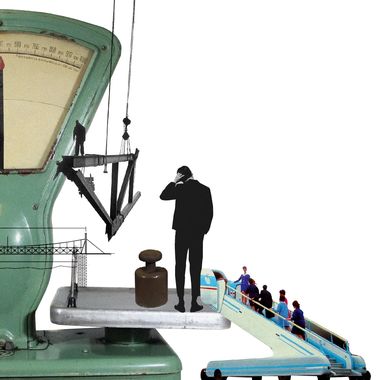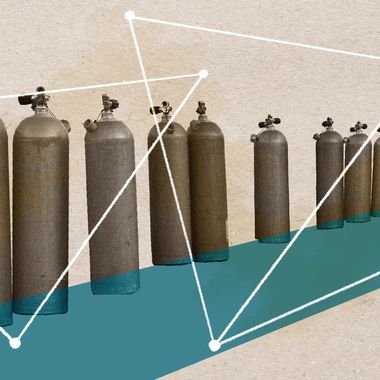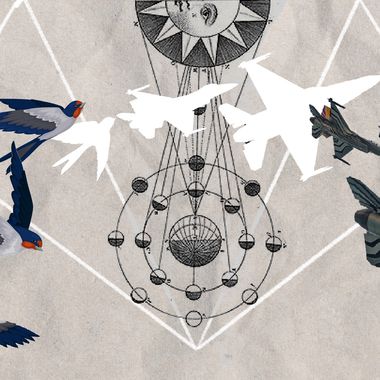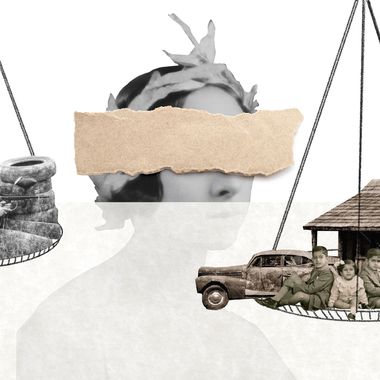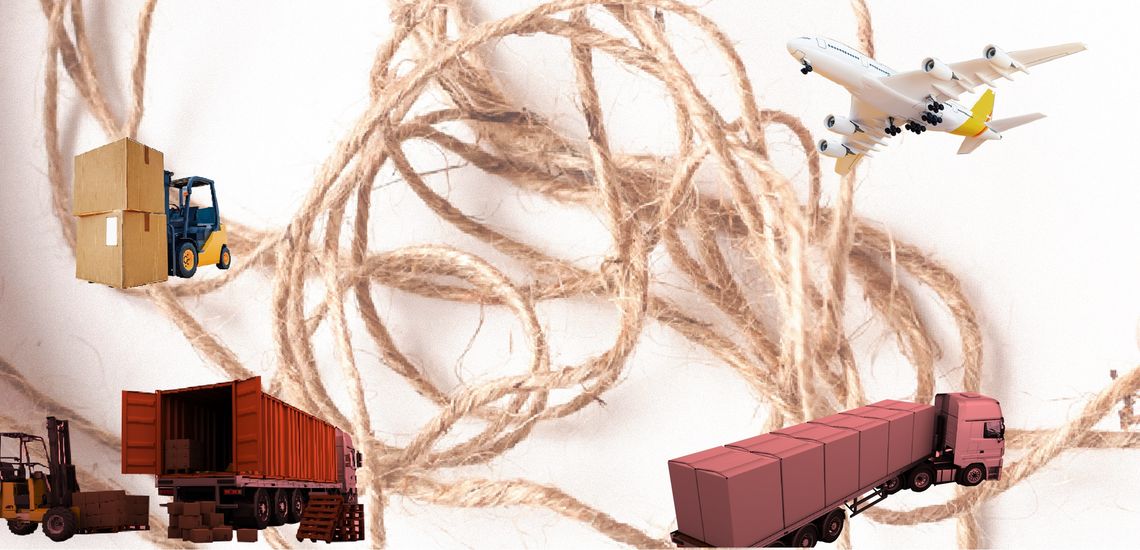
Illustration by Armine Shahbazyan.
The November 10 ceasefire agreement ended the 2020 Artsakh War, resulting in the signing away of large stretches of territory held by the Armenian side for almost three decades and the introduction of Russian peacekeepers. While Azerbaijan has impeded one of its provisions, the exchange of prisoners of war, the last point in the article, unimpeded movement between Nakhichevan and the western regions of Azerbaijan (Article 9) have already entered the discussion stage.
The concept was dangled as a carrot when newly-appointed Minister of Economy Vahan Kerobyan stated the following on November 28, 2020: “Opening the borders will provide wide opportunities. Our exporters will be able to export their products to Russia or other countries through more convenient roads than we have now. Turkish ports will be open to us, and many wide opportunities will be provided. It’s possible that the Azerbaijani market will be open for us and ours for them.”
Concrete steps have already been outlined through a trilateral announcement signed on January 11, 2021, concerning the opening of trade relations and travel. They include creating an intergovernmental working group and expert subgroups that will hold future meetings to hash out details. Soon after, a map started circulating depicting the route of a new railroad link from Yerevan, through Nakhichevan, Syunik and Baku to Russia.
While Armenian businessmen and experts in the field understand the advantages of Armenia’s neighbors (Turkey is not a party to the trilateral agreement but there have been suggestions that they would follow Azerbaijan’s lead.) lifting their blockade against Armenia, they also concede that there are accompanying risks to Armenia’s economy.
At the Whim of a Dictator
Arsen Mkrtchyan is the Director of NOA Wines, which operates vineyards in the Vayots Dzor region. His company currently exports Armenian wine to Russia, China and the United States, but he is apprehensive about the opening of borders.
“Here, economic and political issues diverge. Our leaders have to understand: is the price we are going to pay worth those political concessions that it will have to make? We don’t know what price we are going to have to pay in turn for that,” he warns.
Though current trade routes do allow exporting to the global market, having an alternative road can ease logistical issues, especially as the Lars checkpoint on the Georgian-Russian border is frequently impassable during the winter months. Rail links can also reduce costs.
At the same time, there are concerns whether Armenian cargo through Azerbaijan will be delivered reliably. “Cargo has to be ensured. I’m not so sure that our goods will reach Russia through Nakhichevan and Baku undamaged and unhindered,” says Mkrtchyan, and adds that he doesn’t consider insurance as an exhaustive solution.
“If you want to be compensated for losing all your cargo, you have to pay a lot,” explains Mkrtchyan. “There is also another issue: you already have to go through a lot of trouble to find a partner abroad. It can take from one year to a year and a half to get an order through. Imagine if a container of your ordered goods is sent but then has issues in Azerbaijan. It would cripple your year of work, which no insurance company can fully make whole. Not only is the cost price of the bottle important but also the expected income, which you may not receive.”
Mkrtchyan notes that, when assessing such risks, they would prefer the more expensive current routes until the alternative is proven to be reliable. Azerbaijan’s track record of corruption does not instill confidence.
Positive Expectations Are Naive
Vahram Mirakyan, President of the Mantashov Entrepreneurs Union, believes it naive to have positive expectations from the lifting of the blockade. “Let’s be real,” says Mirakyan. “The reality is that it’s not only the Artsakh conflict that we have to deal with when it comes to Turkey and Azerbaijan. What we have is an Armenian-Turkish conflict, one of the manifestations of which is the Armenian-Azerbaijani conflict. They’re not fighting against Artsakhtsis. Their aim is to exterminate the Armenians. We saw how, immediately after the war, they started to rekindle ideas of taking over Yerevan, Sevan and Syunik. Taking all of this into consideration, we should not seriously expect that we will be able to transport goods through Azerbaijan…”
Mirakyan brings the example of Azerbaijanis who attacked Armenian cargo trucks in Georgia in late January 2021.
According to skeptics, the reason behind these economic decisions is to either create political leverage over Armenia by establishing dependence, or exert influence over Armenia with a “soft power” approach. All those interviewed for this article brought the example of Georgia, where Turkish-Azerbaijani investment is at a massive scale and has taken over much of Georgia’s economy. “It’s no coincidence that the Turks talk about Georgia as an area of Turkish influence,” says economist Suren Parsyan. He expects that Armenia’s economic security and independence could also be put at risk.
Recently, a map prepared by Stratfor, an American company that provides intelligence to companies about geopolitical risk, included Armenia in a proposed “Turkish sphere of influence” by 2050.
New Markets?
Access to the Turkish and Azerbaijani markets for Armenian producers can theoretically have a positive effect on Armenia’s economy. Currently, the volume of products exported from Armenia to Turkey amounts to an average of $2 million a year. The reverse flow from Turkey to Armenia averages $260 million a year. “Our trade turnover is one-sided; we mainly import,” Parsyan explains, adding that Turkey has in fact reduced the import of Armenian products into its market through different means. One well-known incident is when Turkey banned the import of Armenian brandy through court procedures because the bottles had a picture of Mt. Ararat on their label.
There are no guarantees that this policy will not continue, especially when Turkey has the toolbox to do so. Turkey is a member of the World Trade Organization (WTO) and can set up to 48% customs duty on imported goods.
As for exporting to Azerbaijan, Parsyan states that exported goods from Armenia include minerals (such as copper and molybdenum) and light industrial products (cigarettes, canned food, etc.). Azerbaijan is in a more competitive position for these products because of its larger population and economies of scale. Also, the history of conflict would likely inhibit demand for Armenian goods in Azerbaijan.
Competitive Disadvantage
“They will kill local producers. Local goods will not stand a chance in competing with them. They were already being slaughtered by goods imported from there, but what if they start producing here? What will happen?” asks Vahram Mirakyan. He brings the example of serviettes and toilet paper. Selpak, a Turkish manufacturer held a dominant place in the Armenian disposable paper market until the recent embargo on Turkish products that came into effect on January 1. The products would be brought into Armenia through Georgia. Economist Suren Parsyan likewise states that Armenian businesses will have serious competition issues because the volumes produced by Turkish and Azerbaijani firms allow them to offer lower prices. There are several reasons for this: producers there receive state support, energy resources are cheap and the cost of providing these products is also cheap. Also, during the past several years, the devaluation of the national currencies of these two countries has led to a drop in the price for their products.
Ruben Osipyan, President of the Small and Medium Enterprise Cooperation Association, presents these risks more visually with numerical data. According to him, over 90% of Armenia’s 79,000 small and medium enterprises (SMEs) are considered extremely small, averaging only one employee. These are mainly self-employed individuals earning a subsistence living. They are not prone to invest much capital back into their business. “10-20 percent of our SMEs export. The rest focus on the domestic market, which means it’s possible that they won’t be competitive in outside markets,” says Osipyan. “And this, in and of itself, is a risk.” A wave of business closures caused by Turkish firms moving in could create an unemployment crisis for Armenia.
Experts have different positions and proposals on how to increase the competitiveness of local products, including various privileges granted by the state: customs restrictions, purchase quotas, etc. Osipyan has suggestions for new ways to develop exports: collaborating with large online market platforms such as Amazon and Alibaba, regulating the frequency of airplane flights and using the airport’s cargo terminal more effectively.
The Government’s Contradictory and Confusing Steps
What Armenia’s Government plans to do in terms of developing the economy and lifting the trade blockade is still not clear. Moreover, the situation is contradictory and confusing. On October 20, 2020, the Government decided to ban the import of Turkish products, but just a month later, the Minister of Economy was making announcements about the wide opportunities opening the borders would bring. Even now, the working group including the Deputy Prime Ministers of Armenia, Russia and Azerbaijan has met and held discussions on lifting the blockade.
“The process is not transparent at all. The public does not know, for example, what issues the deputy prime ministers are negotiating about,” says Osipyan. “They’re probably developing certain concepts. It would be wise if they at least held discussions with a community of experts. We don’t want to wake up one day to learn that they’ve taken on certain international obligations and bound the state’s hands.”
In response to our inquiries, Deputy Minister of Economy Varos Simonyan stated, “We believe that this embargo [against Turkish goods in effect since January 1] can possibly be extended for another six months, and based on respective research there may be stricter restrictions. Businesses have to take into account that some exceptions may be included in the new list of banned imported goods.”
Confirming Osipyan’s point about the lack of transparency, the response, which took 23 days to provide, did not address our main questions regarding the lifting of economic restrictions in the region.
Below is an interview with slight edits with Sedrak Barseghyan, Chief of Staff to Deputy Prime Minister Mher Grigoryan, on the prospects of lifting the blockade:
Astghik Karapetyan (AK): Has the Armenian government conducted research on the positive and negative consequences on the country’s economy that can be expected from lifting the economic and transport blockade?
Sedrak Barseghyan (SB): The question of course has been discussed in detail with authorized departments within the government. It is an area of focus for the government and all possible outcomes from lifting all economic and transport blockades in the region are being taken into consideration.
AK: If such research has been conducted, can you provide the electronic version of the results or any other source?
SB: Discussions are still ongoing.
AK: There are expert observations that, if the region’s economic and transport blockade is lifted, Armenia can lose its economic independence and become greatly dependent on Azerbaijani and Turkish capital. Is the government considering such risks?
SB: The discussion being held within the government considers it important to assess comprehensive risks, and they are being assessed.
AK: If the government is observing these risks, and other risks as well, then has it already developed mechanisms for protecting Armenia’s economy? What are those mechanisms, and how are they going to be used?
SB: At this point in time, it’s not possible to talk about mechanisms, not until all risks have been assessed and collected in a database.
AK: Are there approximate deadlines for when the process of lifting the region’s economic and transport blockades will start, and what are the first steps going to be?
SB: It’s not possible to define deadlines at this point in time, because there has only been one meeting with the working group. That meeting concluded with setting up subgroups on issues relating to railroads, car and truck transport, and supervising transportation, including safety, borders, customs, sanitary, veterinary, phytosanitary and other areas.
also read
Roots of the Demarcation Issue
By Lusine Sargsyan
The November 10 ceasefire agreement ended the 2020 Artsakh War, but the issue of demarcating the new state borders between Armenia and Azerbaijan has been a major concern since then.
Can Trade Prevent War?
By Artin DerSimonian
Given the growing sense of global multipolarity and the apparent twilight years of the American-anchored liberal international order, Armenia cannot solely rely on friends and allies around the globe to ensure its survival. A more realistic approach is necessary.
Russia’s Partnership With Turkey and What It Means for Armenia
By Zaven Sargsian
Many assumed that Turkey’s direct involvement in the 2020 Artsakh War and thereby its intrusion into Russia’s “near abroad” would be met with hostility by Russia, or at least vocal condemnation. The reaction was mild, writes Zaven Sargsian.
Russia’s Increasing Military Presence in Armenia
By Hovhannes Nazaretyan
When Armenia declared independence in 1991, there was still a large contingent of Soviet troops in the country. Russian military presence, however, stretches back to the early 19th century and now, after the 2020 Artsakh War, is expanding.
Southern Gas Corridor Brings Azerbaijani Gas to the EU
By Anna Barseghyan
The operation of the Southern Gas Corridor raises the geopolitical significance of Azerbaijan and Turkey, contributing to the further isolation of Armenia from regional projects. The EU seems to limit its concern about human rights violations and war crimes in Artsakh to mere lip service.
Implications of the 2020 Artsakh War on Regional Countries
By Hovsep Kanadyan
The 2020 Artsakh War changed the geopolitical picture in the South Caucasus, impacting all the countries in the region. While there were clear winners and losers, some countries both won and lost.
Armenia v. Azerbaijan: On the Frontlines of the Law
By Lusine Sargsyan
The military phase of the 2020 Artsakh War seems to have ended but the legal fight for restoring and upholding human rights is just beginning. Armenia’s Inter-State Application against Azerbaijan to the ECHR marks the beginning of that strategic process.



